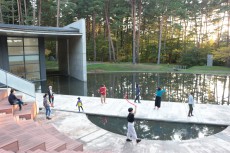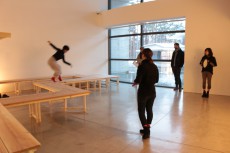
(MO)TION
Looking ahead with dance
MURAKAMI Aya
A dancer actively performing in contemporary dance circles, Yamashita belongs to a dance company and she has choreographed and directed works in her own name.
Her activities at ACAC centered around the dance production based on the boundaries between the forest, buildings and the sky, and three activities of workshop, creation of dance pieces, and exhibition works. She repeated experiments and practices while holding workshops as well as working on her installation and dance production to present at the opening of the exhibition. Furthermore, she kept working even after the exhibition’s opening. Needless to say, she continued holding workshops, and in the process, she started creating dance that corresponded with the other artists’ works in the exhibition space and built up on her practices.
During the residency, she talked about “what dance is.” Her impressive comments included: “Dance is originally spontaneous. Even if your body no longer moves, you can still dance.” “Even if the moving person is not aware, the surrounding people might sometimes call it a dance.”(*1) The contradictory contents of these remarks seem to represent how dance is currently captured. Certainly, who knows how to define dance? Many attempts that she made at ACAC seemed to explore ways to face this question, bridging the awareness gained on one side and developing it on the other side.
Yamashita says that looking at contours in the scenery makes her feel comfortable even in her busy daily life. Her ways to create dance from the boundary in the landscape are derived from that. She decided to call these borderlines “ridgelines,” and drew a line that she felt attractive on paper, beginning with tracing that line carefully, and by moving even small parts of her body, she connected lines and made them into a piece of dance. For example, she first traces with her fingertip a gently-sloping line of a one-stroke drawing depicting the edge of a mountain, then her wrist starts to move influenced by the finger, and next comes the shoulder, and then the hip, and so forth. By paying attention to her physical senses and changes in them as much as she pays attention to the line in front of her, she carefully picks up the chain where the movement of her body and their lines overlap.
She spent most of her weekend during the residency to hold workshops. From the middle of her residency, she began to incorporate simple instruments like a tambourine for the dance performances. The lines she traced in the dance are not only from her memory of the lines drawn on paper, but also from the surrounding scenery and her memory. The motive to create her dance was the moment when her own body overlapped with the surrounding environment. As long as she moves according to the lines surrounding her, and as long as she consciously follows her own body movement, the chain movement expands infinitely.
Yamashita made use of workshops as a place for her own quest, and gained ideas for her exhibition work by confirming tangible feelings that she could share with the participants through their reactions. She presented her installation work, There was a dance born from a ridgeline, in which a visitor could experience vicariously the production process of the dance works. In the gallery space are only pieces of paper hanging on invisible fishing line, a mat, and several notes written with instructions to move. Viewers are asked to take off their shoes at a position in front of the mat, walk on a somewhat cold concrete floor according to the route, step on the soft mat and look at the drawing of the ridgeline. As they proceed, they find a note at their feet, pick it up, interpret written instructions and move their bodies as they understand the notes. They are urged to trace the ridgeline using the small parts of their bodies such as finger, belly button, throat, heel and the tip of their fifth finger. Here, the viewer, just as the workshop participants experienced, will have the experience of keeping their movements synchronized with the line.
When we display dance works, we often exhibit videos and photographs that record dancers’ movements. Yamashita, however, did not choose a duplicate of such a dancing body. This work is also a follow-up experience of her dance production, and it is a dance work to be viewed without the dancer’s body.(*2) It seems to make a dance work exist by having the participant’s body dominated by Yamashita’s dance. When we remember her remark, “dance is initially spontaneous,” however, we understand that if the moving person does not realize it, dance is not supposed to be born there. So, in this work, such questions are raised: “Will dance be established without (duplicate of) body presentation?” and “On which side does dance exist, the dancer’s or the viewer’s side?”
Yamashita has questions about the current situation where dance is appreciated by its duplication, and a dance work comes into existence on the premise of a dancer’s body. She quietly confronts them, and it is a kind of attitude that Yamashita practiced at ACAC. She has acquired here the freedom to ask questions regarding dance by means of an exhibition that belongs to a different field. Just like that, the future of dance might be much freer and more open than we think.
(*1) Yamashita made similar comments in the interview on December 8, 2018. AC2, no. 20 (Aomori: Aomori Contemporary Art Centre, 2018).
(*2) Leaflet, Ayako Yamashita’s installation, ACAC, 2018.
〇動
2018年10月27日(土)-12月9日(日)10:00- 18:00、会期中無休、無料
山下 彩子
YAMASHITA Ayako

≪稜線から生まれたダンスがあった≫ There was a dance born from a ridgeline
ダンスと先に
村上 綾
山下はコンテンポラリーダンスの分野で活動するダンサーとしてダンスカンパニーに所属し作品に出演するかたわら、個人の名義で振付や演出も行い作品を発表してきた。
ACACでは森や建物などの輪郭線から制作するダンスを軸に、ワークショップ、ダンス作品の制作、展示作品の制作の3つの活動を行った。ワークショップを開催していく中でいくつもの実験と実践を重ね、同時に展覧会に向けて、インスタレーションの制作とオープニングで披露するダンス作品の制作を進行させた。さらには展覧会がオープンしてからも山下は動き続けた。ワークショップの開催の継続はもちろん、いつの間にか展覧会場の他の作家たちの作品と呼応するダンスを創作し始め、実践を重ねていった。
彼女は滞在中に「ダンスとは何か」に関わる話をしていた。なかでも「ダンスは本来能動的なもので、たとえ体が動かなくなったとしてもダンスが出来る」といった発言や「動いている人に自覚がなくても、周りの人が『あれはダンスだ』と言う場合もあるでしょう?」(*1)といった言葉が印象的だった。この2つの発言の相反する内容は、それはダンスの現在の捉えられ方の実際を表しているように思えた。確かに、誰がどうやってダンスを定義するのだろうか?彼女がACACで行った沢山の試みは、この問いに向き合う方法を探っていくように、一方で得た気付きを他方で発展させていった。
山下は景色の中に見える輪郭線を見ると自身のせわしない日常の中でも心が落ち着くのだと言う。景色の中の輪郭線からダンス作る方法はそのことに由来している。彼女はこれらの線を「稜線」と呼ぶことにして、魅力を感じた線を紙に描き、丹念になぞることから始め、身体の細かな部分までも使って動かすことで、それらの線をつなげて一つのダンスにしていった。例えば、山の際を描いた一筆書きのなだらかな線を、初めは指先でなぞりながら、その動きにつられて手首が動き出したと思ったら線のつづきを手首で、そうするうちに肩が動き出したと思ったら次は肩で、次は腰で、と繰り返していく。目の前の線と同じくらい自分の身体感覚とその変化に注意して、自分の身体の動きとその線が重なっていく連鎖を丁寧に気づいて拾い上げていくのである。
山下は滞在中の週末のほとんどをワークショップにあてた。滞在期間の中盤からは、タンバリンなどシンプルな楽器と共にショーイングも開催した。その時なぞっていく線は紙の上に描いたものの記憶だけではなく、周辺の景色や、自身の記憶の中に存在することになる。ダンスの制作のきっかけを自身の身体と周辺の環境が重なり合う瞬間として、ダンスを生み出していった。自分が周りにある線に合わせて動く限り、自身の身体の動きを意識して追っていく限り、その連鎖は無限に広がるのである。
山下は、ワークショップを自身の探求の場としても活用し、参加者の反応から共有できる身体感覚を確かめることで展示作品のアイデアを得た。ダンス作品を制作する過程を追体験するようなインスタレーション作品《稜線から生まれたダンスがあった》を発表した。ギャラリーには細くて見えないテグスによって浮かぶ紙とマット、動きの指示の書かれた数枚のメモしか見当たらない。鑑賞者はマットよりも手前の位置で履物を脱ぐように促され、ひんやりしたコンクリートの床の上を順路に従って歩き、柔らかなマットの上に上がって稜線の書かれたドローイングを眺める。進んでいくうちに見つけたメモを足元から拾い上げ、書かれた指示を解釈して自身で体を動かしていく。描かれた稜線を、指をはじめ、へそや喉、かかとや小指のへりといった体の小さな部分まで使って、なぞるように促される。ここで鑑賞者は、ワークショップで参加者が体験したように、線と自身の動きを同期させ続けるという経験をすることになる。
ダンス作品を展示する場合、映像や写真といったダンサーの動きの記録が用いられることが多い。しかし山下はそういった踊る身体の複製を選ばなかった。この作品は彼女のダンス制作の追体験でもあり、ダンサーの身体が不在の状態で観るダンス作品(*2)でもある。それは作品を体験する人の身体に山下のダンスを憑依させることで、ダンス作品を成立させているようにも見える。しかし「ダンスは本来能動的なものである」という彼女の言葉を思い出せば、動く人が自覚しなければそこにダンスは生れていないことになる。つまり、この作品では「身体(の複製)の提示なしでダンスが成立するか」「踊る人と見る人のどちら側にダンスがあるのか」という問いが浮かび上がってくる。
複製によってダンスが鑑賞されること、さらにはダンサーの身体の存在ありきで作品が成り立つこと、といった現状に対して疑問を持ち、静かに対峙する。それがACACで山下が実践してきた姿勢である。ダンスを取り巻く疑問を、展示という畑違いの方法で問う自由さを山下はACACで獲得したのである。それと同様に、ダンスが存在する先は私たちが思うよりもずっと自由で開かれているのかもしれない。
(*1)インタビュー(2018年12月8日)でも同様の発言をしている。『AC2』20号、国際芸術センター青森、2018年
(*2)山下が展覧会のハンドアウトに寄せたテキストより。

≪稜線から生まれたダンスがあった≫ There was a dance born from a ridgeline


≪稜線日和≫ A Perfect Day to See a Ridgeline
撮影:すべて山本 糾
